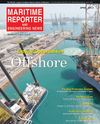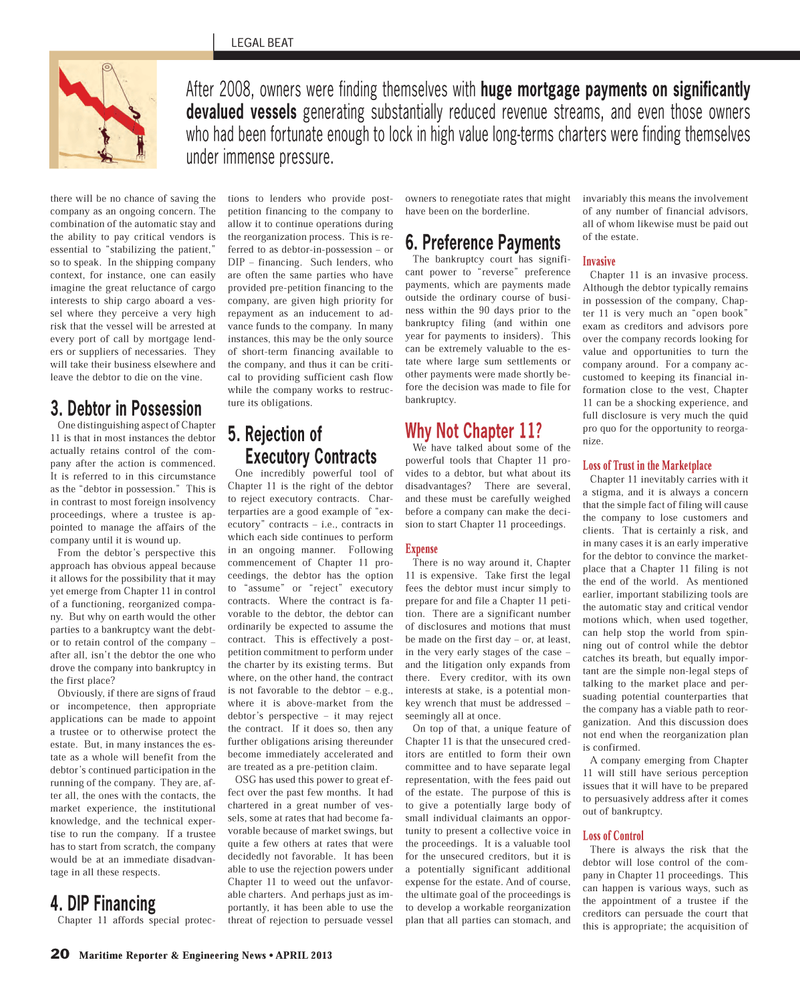
Page 20: of Maritime Reporter Magazine (April 2013)
Offshore Energy Edition
Read this page in Pdf, Flash or Html5 edition of April 2013 Maritime Reporter Magazine
20 Maritime Reporter & Engineering News ? APRIL 2013 LEGAL BEAT there will be no chance of saving the company as an ongoing concern. The combination of the automatic stay and the ability to pay critical vendors is essential to ?stabilizing the patient,? so to speak. In the shipping company context, for instance, one can easily imagine the great reluctance of cargo interests to ship cargo aboard a ves- sel where they perceive a very high risk that the vessel will be arrested at every port of call by mortgage lend-ers or suppliers of necessaries. They will take their business elsewhere and leave the debtor to die on the vine.3. Debtor in PossessionOne distinguishing aspect of Chapter 11 is that in most instances the debtor actually retains control of the com-pany after the action is commenced. It is referred to in this circumstance as the ?debtor in possession.? This is in contrast to most foreign insolvency proceedings, where a trustee is ap-pointed to manage the affairs of the company until it is wound up.From the debtor?s perspective this approach has obvious appeal because it allows for the possibility that it may yet emerge from Chapter 11 in control of a functioning, reorganized compa- ny. But why on earth would the other parties to a bankruptcy want the debt-or to retain control of the company ? after all, isn?t the debtor the one who drove the company into bankruptcy in the first place? Obviously, if there are signs of fraud or incompetence, then appropriate applications can be made to appoint a trustee or to otherwise protect the estate. But, in many instances the es-tate as a whole will benefit from the debtor?s continued participation in the running of the company. They are, af- ter all, the ones with the contacts, the market experience, the institutional knowledge, and the technical exper- tise to run the company. If a trustee has to start from scratch, the company would be at an immediate disadvan-tage in all these respects.4. DIP FinancingChapter 11 affords special protec- tions to lenders who provide post-petition financing to the company to allow it to continue operations during the reorganization process. This is re- ferred to as debtor-in-possession ? or DIP ? financing. Such lenders, who are often the same parties who have provided pre-petition financing to the company, are given high priority for repayment as an inducement to ad-vance funds to the company. In many instances, this may be the only source of short-term financing available to the company, and thus it can be criti- cal to providing sufficient cash flow while the company works to restruc-ture its obligations.5. Rejection of Executory ContractsOne incredibly powerful tool of Chapter 11 is the right of the debtor to reject executory contracts. Char- terparties are a good example of ?ex-ecutory? contracts ? i.e., contracts in which each side continues to perform in an ongoing manner. Following commencement of Chapter 11 pro- ceedings, the debtor has the option to ?assume? or ?reject? executory contracts. Where the contract is fa- vorable to the debtor, the debtor can ordinarily be expected to assume the contract. This is effectively a post- petition commitment to perform under the charter by its existing terms. But where, on the other hand, the contract is not favorable to the debtor ? e.g., where it is above-market from the debtor?s perspective ? it may reject the contract. If it does so, then any further obligations arising thereunder become immediately accelerated and are treated as a pre-petition claim.OSG has used this power to great ef-fect over the past few months. It had chartered in a great number of ves-sels, some at rates that had become fa-vorable because of market swings, but quite a few others at rates that were decidedly not favorable. It has been able to use the rejection powers under Chapter 11 to weed out the unfavor- able charters. And perhaps just as im- portantly, it has been able to use the threat of rejection to persuade vessel owners to renegotiate rates that might have been on the borderline.6. Preference Payments The bankruptcy court has signifi-cant power to ?reverse? preference payments, which are payments made outside the ordinary course of busi-ness within the 90 days prior to the bankruptcy filing (and within one year for payments to insiders). This can be extremely valuable to the es-tate where large sum settlements or other payments were made shortly be-fore the decision was made to file for bankruptcy. Why Not Chapter 11?We have talked about some of the powerful tools that Chapter 11 pro- vides to a debtor, but what about its disadvantages? There are several, and these must be carefully weighed before a company can make the deci-sion to start Chapter 11 proceedings. ExpenseThere is no way around it, Chapter 11 is expensive. Take first the legal fees the debtor must incur simply to prepare for and file a Chapter 11 peti- tion. There are a significant number of disclosures and motions that must be made on the first day ? or, at least, in the very early stages of the case ? and the litigation only expands from there. Every creditor, with its own interests at stake, is a potential mon-key wrench that must be addressed ? seemingly all at once.On top of that, a unique feature of Chapter 11 is that the unsecured cred- itors are entitled to form their own committee and to have separate legal representation, with the fees paid out of the estate. The purpose of this is to give a potentially large body of small individual claimants an oppor- tunity to present a collective voice in the proceedings. It is a valuable tool for the unsecured creditors, but it is a potentially significant additional expense for the estate. And of course, the ultimate goal of the proceedings is to develop a workable reorganization plan that all parties can stomach, and invariably this means the involvement of any number of financial advisors, all of whom likewise must be paid out of the estate.InvasiveChapter 11 is an invasive process. Although the debtor typically remains in possession of the company, Chap- ter 11 is very much an ?open book? exam as creditors and advisors pore over the company records looking for value and opportunities to turn the company around. For a company ac-customed to keeping its financial in-formation close to the vest, Chapter 11 can be a shocking experience, and full disclosure is very much the quid pro quo for the opportunity to reorga- nize.Loss of Trust in the Marketplace Chapter 11 inevitably carries with it a stigma, and it is always a concern that the simple fact of filing will cause the company to lose customers and clients. That is certainly a risk, and in many cases it is an early imperative for the debtor to convince the market-place that a Chapter 11 filing is not the end of the world. As mentioned earlier, important stabilizing tools are the automatic stay and critical vendor motions which, when used together, can help stop the world from spin-ning out of control while the debtor catches its breath, but equally impor- tant are the simple non-legal steps of talking to the market place and per- suading potential counterparties that the company has a viable path to reor- ganization. And this discussion does not end when the reorganization plan is confirmed. A company emerging from Chapter 11 will still have serious perception issues that it will have to be prepared to persuasively address after it comes out of bankruptcy. Loss of Control There is always the risk that the debtor will lose control of the com-pany in Chapter 11 proceedings. This can happen is various ways, such as the appointment of a trustee if the creditors can persuade the court that this is appropriate; the acquisition of After 2008, owners were finding themselves with huge mortgage payments on significantly devalued vessels generating substantially reduced revenue streams, and even those owners who had been fortunate enough to lock in high value long-terms charters were finding themselves under immense pressure. MR #4 (18-25).indd 20MR #4 (18-25).indd 204/1/2013 1:38:49 PM4/1/2013 1:38:49 PM

 19
19

 21
21
